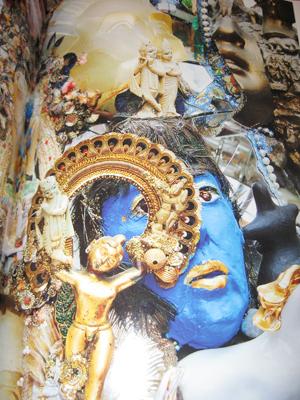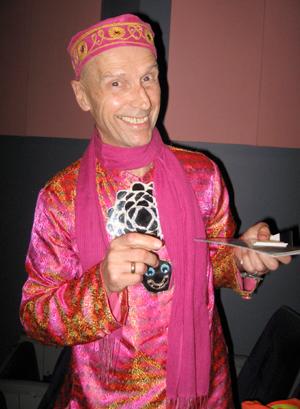
Credit: Andrew Logan Rejoice (Flowers Gallery publisher)
To suggest that Andrew Logan’s soul is made entirely of glitter, sparkly bits and bedazzled fabulousness is barely a stretch.
The eccentric Brit, who was in Vancouver to attend a screening of his indie bio pic, The British Guide to Showing Off, at the International Film Festival on Oct 9, has travelled extensively, hobnobbed with the art scene elite, sculpted, and started the Alternative Miss World pageant, a raucous competition with an array of colourful participants.
Xtra had a chance to chat with Logan about the pageant, his newfound fear of heights, how igloos make him thirsty and how he would like to be remembered. But first a little word association…
Xtra: Igloo.
Andrew Logan: Cocktails!
Pizza.
Ummm, Japan.
Sex.
Essential.
What inspires you artistically?
Now, I suppose, in my life it is the universe and friends that inspire me. Earlier on, as I started my career, it was the surrealists and William Blake, the poet and painter, and [Spanish modern architect] Antoni Gaudí, of course.
You studied architecture in university in the UK. How did you make the transition from architect to artist?
It was about being confident, which I think is such a problem with young people. And I took this acid trip in college. I threw this orange at the wall and it just kept going and didn’t plop on the floor. What it gave me was confidence and made me think, ‘Oh, I can do that.’ So I started to make objects and did a little installation in my digs at Oxford and then went on to do a show called The Ten Sitting Rooms at the Institute of Contemporary Arts in London in 1970.
You began the Alternative Miss World pageant in 1972. In the past, when you’ve been asked why you started it, you’ve said that you loved to host parties and the competition was just an extension of that passion. In the film The British Guide to Showing Off, a pageant participant mentions that one year the event got so wild that an orgy ensued. Are these the kinds of parties you had in mind?
[laughing] Not at all! I have been described as the “Auntie of the AMW,” so I’m kind of slightly proper, but I allow everything to happen within the AMW.
The only thing I did ban was a request from a performance artist that wanted to skin a live chicken on stage at the show. I just said, “I’m sorry. I’m not interested.” I abhor violence. I know it’s part of our human nature and we have yin and yang and all of this, but I find that quite disturbing. But otherwise, everything else goes!
You were known to hang with pop culture icon Andy Warhol and performance artist Divine. Did these contemporaries influence your art?
Well Divine, of course. He got me started doing portraiture — him and my parents. I said to him, ‘I must do your head because it’s so fabulous!’ He had the most beautiful head — big but beautifully proportioned nose. All of his proportions were exquisite. That’s why he made this amazing-looking woman. Divine was a sweet, sweet man — naughty, but sweet.
Divine was definitely a friend, where Andy was a different person. When I’d go to New York I would visit him. At every party at that time in New York he was like wallpaper; he was there.
You have said that obtaining sponsorship to host a future Alternative Miss World is the biggest challenge. Do you think the lack of interested sponsors reflects a society still unwilling to accept the blatant, eccentric, hyper-sexual, in-your-face pageantry that is the AMW competition?
I think most people like to know what is going to happen, and you don’t know what is going to happen at AMW, so that might put off sponsorship. Nothing bad has ever happened at the A — extraordinary things, but nothing bad…
Of course, now there are so many club events and parties. There’s a whole culture based on parties, that it seems it’s become one other thing among the rest.
[But] there’s only one Andrew Logan’s AMW. It’s like a big sculpture. The flavour is me. It’s my biggest piece.
Speaking of big pieces, would you call your art sexual?
Sometimes, yes. I think good art would have to be sexual, actually. Because that’s our very being.
Have you faced specific challenges as a queer artist?
I’m so into the work and creating things of joy and happiness and celebration, and I’ve been very lucky, I suppose, to have always had some support somewhere.
Tell me a secret… something that you’ve never told anyone else.
I tell most people most things, so I can’t really think of anything. With me there is no hidden agenda. What you see is what you get.
Do you have any phobias?
I didn’t, but now I find that when I’m standing on the edge of a cliff I get a bit dizzy, which I never felt when I was in my 20s. Perhaps that comes with age.
You just celebrated a birthday. Happy birthday! Now that you’re a spry 66, what advice would your 66-year-old self give to your 20-year-old self?
I was given an honorary doctorate at a university in the UK and I had to give the students advice, and I said, “Look, you’re all ambitious and that’s great, and by all means be ambitious and work hard, but also be very conscious of your fellow human beings. Be kind and compassionate.”
I think that is the most important advice to give to young people.
Is this the same advice that you would give to young, aspiring queer artists?
Live your dream, of course. Work hard and never give up. And if it doesn’t come, if you don’t have success, just keep working. Art is not about getting rich; it never was. It is really about seeing one’s interpretation of the world.
How does Andrew Logan want to be remembered?
For making the world smile.

 Why you can trust Xtra
Why you can trust Xtra


